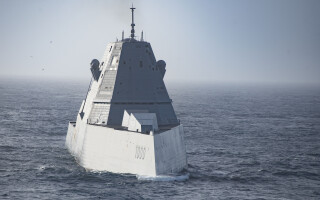Navy announces imminent RFP plan for aircraft carrier-based UAS
NewsNovember 16, 2012

SPRINGFIELD, VA. The U.S. Navy has announced a plan to release an RFP before the end of 2012 for the Unmanned Carrier-Launched Surveillance and Strike (UCLASS) aerial system. The RFP for the unmanned platform, which will launch from Navy aircraft carriers, was announced on November 8th by U.S. Navy Deputy Program Executive Officer Patrick Buckley.
Though estimated delivery of roughly six UCLASS platforms to a carrier air wing for training is scheduled for 2020, according to Buckley the platforms will be based on mature technology. He stated that proposals will be accepted for builds based on Commercial Off-The-Shelf (COTS), Modified Off-The-Shelf (MOTS), or new components containing mature technology that have been proven in relevant operations. However, the design will be rapidly upgradeable for weapons, sensors, and stealth systems.
The UCLASS RFP is modularized into three segments, which are the UCLASS platform and mission systems, a Command and Control (C2) system, and carrier upgrades for support of unmanned platforms. The Navy plans to act as the lead systems integrator, and will provide interface and data specifications to the winning contractor.
The implication for major U.S. defense primes is that they will leverage technology, derivatives, and lessons from current programs. Northrop Grumman is expected to draw from its X-47B Unmanned Combat Air System Demonstration (UCAS-D) program currently employed by the Navy for evaluation of UASs on aircraft carriers, while Boeing Company’s X45-C Phantom Ray, General Atomics’ Predator-C Avenger, and Lockheed Martin’s RQ-170 Sentinel and/or Sea Ghost platforms are expected to be pulled from as well. Government-owned technologies developed under the UCAS-D program will be made available to all potential UCLASS contractors.
The stealth aircraft are expected to see action in the Western Pacific against anti-access and area denial threats, but will not be solely deployed for those operations. Intended for use in Intelligence, Surveillance, and Reconnaissance (ISR) operations, the UCLASS platforms are also expected to have significant strike capability.
The UCLASS platform RFP was delayed for two years by debate over the system’s technological requirements, as well as continuous budgetary limitations. Despite the fairly high priority of the UCLASS platform, current budgetary considerations could still have an effect on the program.
More information on the Navy’s UCLASS platform and proposal is available on Buckley’s November 8 power point presentation at http://opsy.st/U3aV9K.






